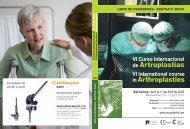cadera / hip - Active Congress.......
cadera / hip - Active Congress.......
cadera / hip - Active Congress.......
You also want an ePaper? Increase the reach of your titles
YUMPU automatically turns print PDFs into web optimized ePapers that Google loves.
MARTES / TUESDAY<br />
88<br />
the outcome of stem fi xation. Reducing the<br />
diameter of the neck from 12.5 to 10mm had<br />
no effect on wear but reduced cup loosening<br />
by over 50%. Proponents of the mechanical<br />
theory have a number of solutions; the proponents<br />
of the biological theory of component<br />
loosening can either modify tissue response<br />
or abandon the procedure. With new materials<br />
and a better understanding of the problem<br />
of osteolysis, it is likely that the subject will<br />
become of academic interest only.<br />
INTERPRETING<br />
OSTEOLYSIS DEFECTS<br />
C. A. Engh<br />
Anderson Orthopaedic Research Institute<br />
Alexandria, VA, USA<br />
Osteolysis is a frequent radiographic fi nding<br />
complicating cementless total <strong>hip</strong> arthroplasty.<br />
When the acetabular cups are<br />
poorly fi xed, osteolysis dissects around the<br />
non-bone ingrown interface causing symptomatic<br />
cup loosening. This type of lysis has<br />
been termed linear osteolysis. Well-fi xed<br />
acetabular components develop expansile<br />
lysis. These lesions develop when joint fl uid<br />
containing particulate debris invades soft<br />
bone near the joint. The communication<br />
pathway between these lesions and the joint<br />
can be either through holes in modular cups<br />
or around the rim with no holed non-modular<br />
cups. When lesions develop through the<br />
holes in the cup and remain small they are<br />
usually not visible on AP radiographs since<br />
they are hidden behind the cup. However<br />
once these lesions develop a volume larger<br />
than 10 cubic centimeters they usually become<br />
visible on an AP radiograph. Cups<br />
without holes develop expansile lysis around<br />
the rim. These lesions usually develop at the<br />
superolateral or inferomedial edges of the<br />
cup and their progression and size can be<br />
more easily followed on plain radiographs.<br />
Since expansile osteolysis usually does not<br />
result in cup loosening, these lesions are<br />
asymptomatic.<br />
We have found that computed tomography<br />
(CT) is a better diagnostic tool for detecting<br />
plain pelvic osteolysis than x-rays. We do<br />
not recommend obtaining CT scans routinely<br />
because it is costly and associated with a high<br />
radiation dosage. However, once osteolysis<br />
is suspected on x-ray we obtain a CT scan<br />
to confi rm the diagnosis. We also use CT<br />
scans to determine if the lesions are rapidly<br />
expanding.<br />
If it is determined that a patient needs revision<br />
surgery, a CT scan is also useful for planning<br />
the surgery. We use the CT to determine<br />
osteolysis volume, whether or not the osteolysis<br />
communicates with the joint space and<br />
whether the lesion is contained by the medial<br />
wall. The three-dimensional appreciation of<br />
the lesion location obtained from the CT images<br />
also help the surgeon in planning the<br />
best surgical access route for curetting and<br />
grafting the defect. During surgery we recommend<br />
retaining well fi xed cups. We have four<br />
objectives: 1) to decrease polyethylene wear<br />
by replacing the polyethylene liner with one<br />
that will wear less, 2) to remove the tissue<br />
producing the lysis, 3) to fi ll the defect with<br />
a bone graft substitute, and 4) to attempt to<br />
block the communication pathway between<br />
the defect and the joint space. Finally, we<br />
found that CT is a much better method for<br />
evaluating the results of our treatment than<br />
plain radiographs.





